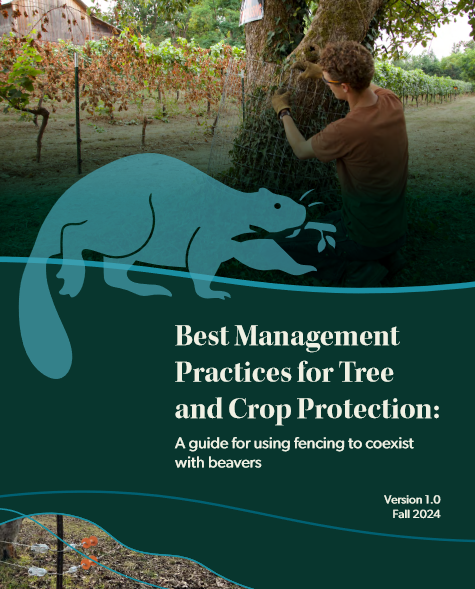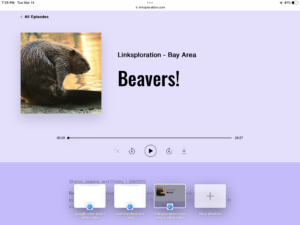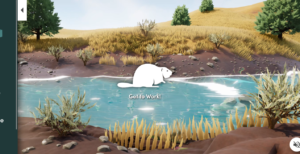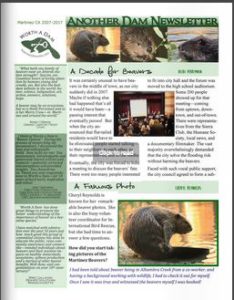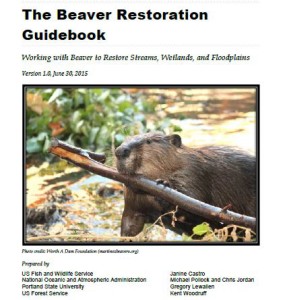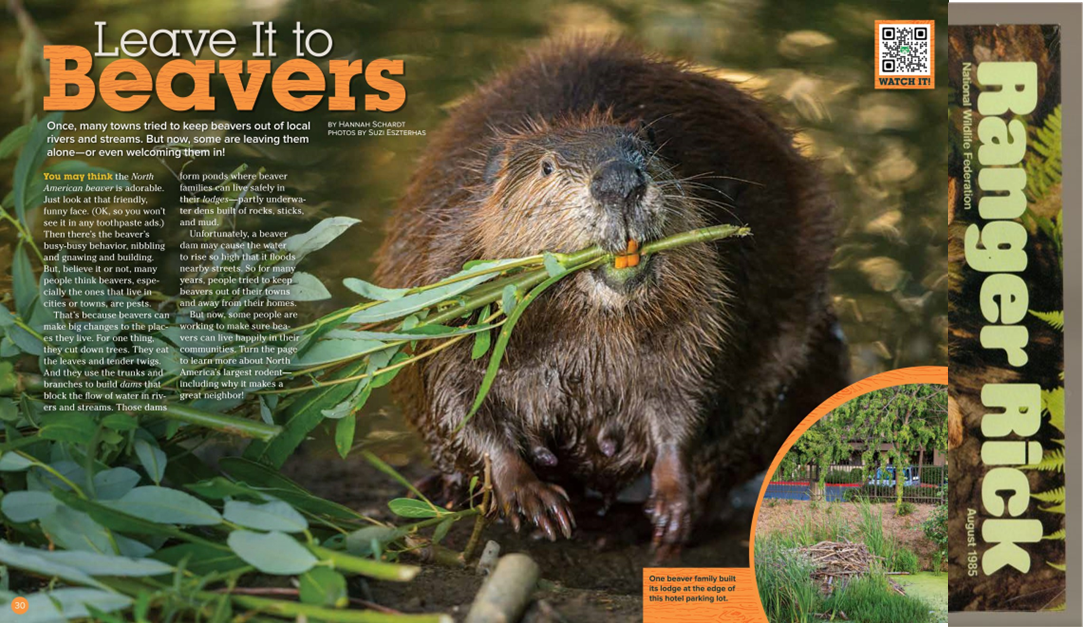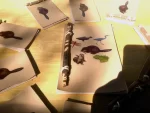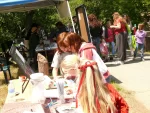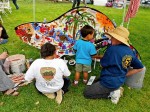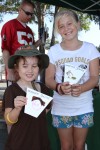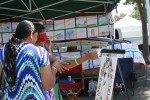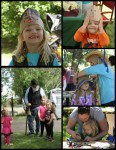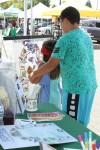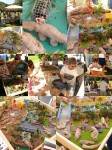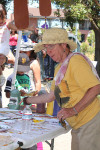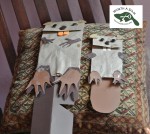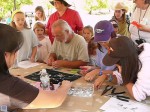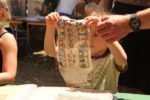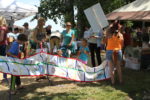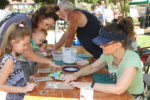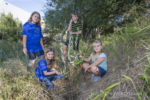One of the things I don’t get to read enough is other blogs that talk about watching beavers. Either there aren’t very many or my filters miss them, but I’m always happy when one shows on the horizon. And this was was a special treat written by Sara Wright.
Nature’s Most Industrious Builder

A wide slow moving stream meandered its way to the sea below the house on the hill and beavers had made a solid dam and erected a domed lodge in the center of the stream. Early in the summer the parents would swim up to me with their kits as I sat quietly on my bench by the water (a bench my father had built for his daughter.) Watching those furry little heads with bright beady eyes peer at me curiously as they swam next to their parents is a sight that I will never forget.
 I soon learned the lodge was occupied by three generations of beavers. The beavers spent part of each summer “logging” the poplars at the edge of the stream. They created open mud slides that led to open water and every night I would sit on the little bench and watch these industrious creatures cut off the branches and swim with their small logs to the dam. Upon arrival they gnawed smaller branches off the logs divesting them of most of the leaves which they ate. They took some to the dam to shore it up and repair any leaks. As long as I sat quietly the beavers went about their work as if I wasn’t even there, but if I stood up suddenly or tried to rid myself of mosquitos by waving my hands, one beaver or another would slap his tail making a great fuss! By midsummer the little kits could be seen swimming with a slender stick or two towards the lodge imitating their parents. There was something about those bright-eyed little kits that stole my heart. Later in the summer the beavers began to disappear under water with tender poplar branches. Those tasty leaves and sticks would feed them throughout the coming winter.
I soon learned the lodge was occupied by three generations of beavers. The beavers spent part of each summer “logging” the poplars at the edge of the stream. They created open mud slides that led to open water and every night I would sit on the little bench and watch these industrious creatures cut off the branches and swim with their small logs to the dam. Upon arrival they gnawed smaller branches off the logs divesting them of most of the leaves which they ate. They took some to the dam to shore it up and repair any leaks. As long as I sat quietly the beavers went about their work as if I wasn’t even there, but if I stood up suddenly or tried to rid myself of mosquitos by waving my hands, one beaver or another would slap his tail making a great fuss! By midsummer the little kits could be seen swimming with a slender stick or two towards the lodge imitating their parents. There was something about those bright-eyed little kits that stole my heart. Later in the summer the beavers began to disappear under water with tender poplar branches. Those tasty leaves and sticks would feed them throughout the coming winter.
Yup. We’ve all been there. Once your heart is touched by a beaver nothing is ever quite the same. Beavers change things. That’s what they do. I am remembering a certain magical morning lo these many years ago when Jon and I counted 4 kits munching willow branches,
[wonderplugin_video videotype=”mp4″ mp4=”https://www.martinezbeavers.org/wordpress/wp-content/uploads/2018/08/four.mov” webm=”” poster=”” lightbox=0 lightboxsize=1 lightboxwidth=960 lightboxheight=540 autoopen=0 autoopendelay=0 autoclose=0 lightboxtitle=”” lightboxgroup=”” lightboxshownavigation=0 showimage=”” lightboxoptions=”” videowidth=600 videoheight=400 keepaspectratio=1 autoplay=0 loop=0 videocss=”position:relative;display:block;background-color:#000;overflow:hidden;max-width:100%;margin:0 auto;” playbutton=”https://www.martinezbeavers.org/wordpress/wp-content/plugins/wonderplugin-video-embed/engine/playvideo-64-64-0.png”]
The first year I spent beaver -watching my father died suddenly on November 9th (the anniversary of his death is today, just three days before the full beaver moon). Just before I got the call I awakened from a dream that simply said:
“Your dad has become a beaver.”
I had to stop here and gasp. The first time I ever saw our beavers I was with my father crossing the escobar bridge. One of the profound coincidences that lurked in the PBS “Leave it to Beavers” film is that while producer Jari Osbourne was working on it her own father died. And her senior assistant’s father also died. And the morning they sent me this film to preview for my feedback I received the phone call that my father also had died.
A series of random coincidences attached profoundly to beavers.
After my father’s untimely death I thought a lot about the relationship between my father and the beavers. The one hobby that my father cultivated when he wasn’t working professionally was carpentry. He was what I would call an extraordinary builder and finish carpenter in his spare time. He and my grandfather built one of the homes we lived in and my father designed and engineered the entire enterprise.
To dream that my dad had become a beaver on the day of his death after I had spent an entire summer submerged in the beavers’ world seemed uncanny, prescient. After he died whenever I watched those beavers I also saw my dad, remembering how hard he worked, how generous he was to others in need, how loyal he was to his family. To think of my dad as a beaver brought me enormous comfort and gave me some hope that something of him lived on in a positive way.
As thanksgiving approached that first year I knew that I would be spending the weekend alone except for the beavers, who by this time, had disappeared under ice. I decided to honor my father and the beavers together by giving my friends a present. So on thanksgiving day I took my handsaw and chopped down two tender poplars after asking for permission to do so… Next I took a crowbar and bored a big hole in the ice not far from the lodge and stuffed the first poplars into icy black waters. Late that day I sat on my frozen bench and called to the beavers, telling them that I had a present for them. I stayed there until almost dusk half frozen – hoping for a sleek brown head to appear, but of course no one did. Yet, when I walked up the hill, I felt as if I had done something important that mattered.
Just this morning I sent Sara’s post to Jari who was very moved and thankful Today is Canadian remembrance day. And what a deep way to remember. One of my last carefree days with my father, before his illness, I spent making a manger in his workshop to use for the beaver family a friend had made me out of clay. I’m sure you’ve seen it before because I use it every holiday for a creche sceen and it always makes me remember our happier days with him.
The next morning I raced down the hill to the stream, and to my amazement and joy, the poplar branches had disappeared! For the next three days I repeated poplar gift giving after reopening the hole in the ice, though I never glimpsed my friends.
In a few days the cold set in for good and a light covering of snow covered the lodge. I loved the fact that the beavers were warm and toasty in their house under the ice. For some reason just knowing they were there brought me an amazing amount of comfort, and all that winter not one day ever passed when I didn’t think of my dad with love.
Me either. Beautifully written Sara Wright. And than you for a morning of remembrances.
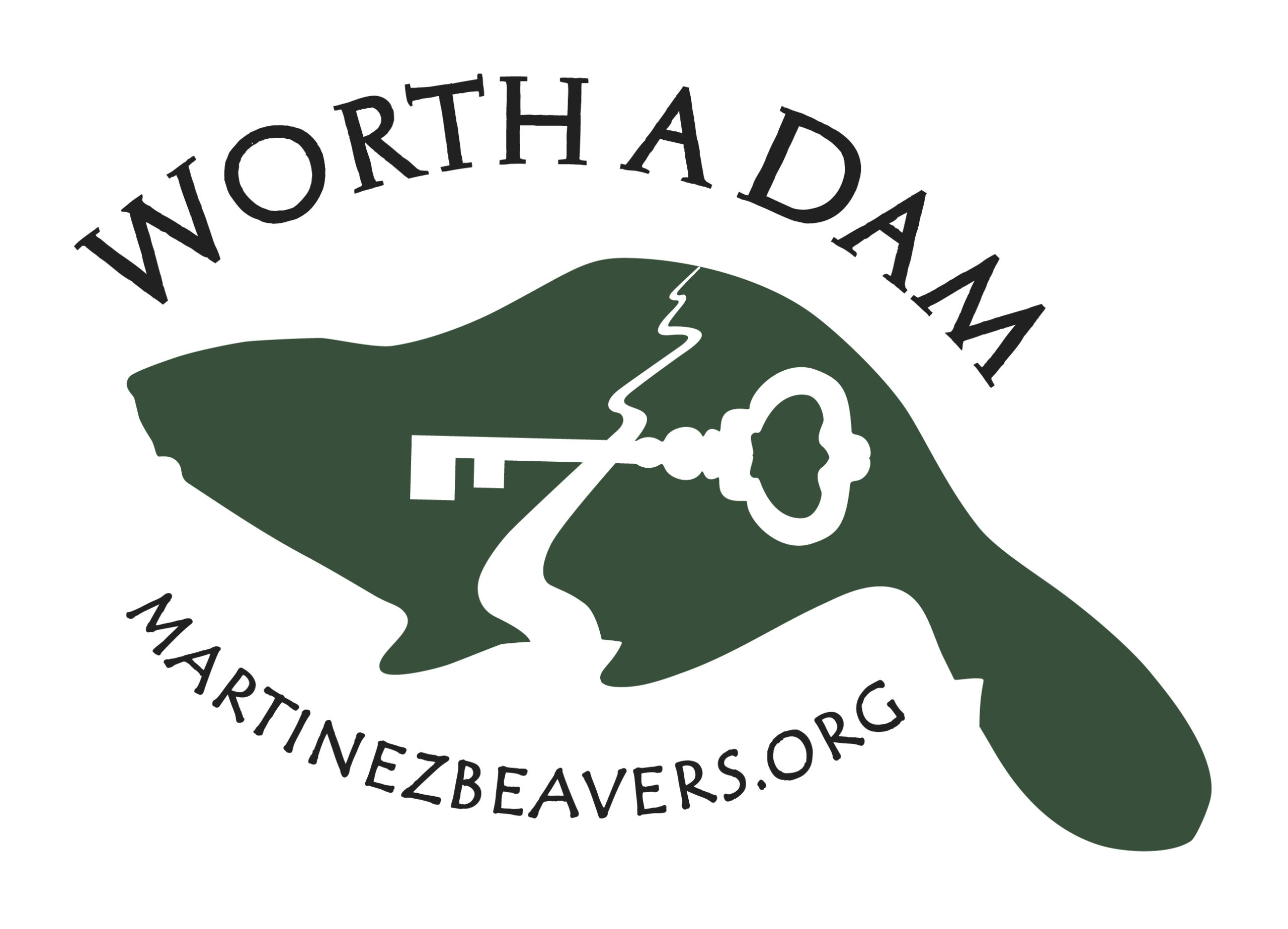




 During this time the flow and movement of the Logan River was much different, in part because of the beaver families who built their homes and dams up and down the waterway. The dams created ponds whose waters seeped into the valley bottoms raising the water table and saturating the sponge.
During this time the flow and movement of the Logan River was much different, in part because of the beaver families who built their homes and dams up and down the waterway. The dams created ponds whose waters seeped into the valley bottoms raising the water table and saturating the sponge. “You know, Joey of Utah!” She explained impatiently and it started to dawn on me.
“You know, Joey of Utah!” She explained impatiently and it started to dawn on me.

